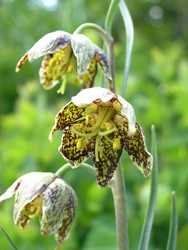Oh my goodness! Unless you are a Tree of Life developer,
you really shouldn't be here. This page is part of our beta test site, where we
develop new features for the ToL, often messing up a thing or two in the
process. Please visit the official version of this page, which is available
here.

Investigation
Fritillaria atropurpurea (Spotted Fritillary) by James
1sagebrush3

Fritillaria atropurpurea. © 2005 emily
Lakota name: caŋĥlőġaŋ maķătola (it means blue earth weed)
 Listen to Lakota Plant Name: caŋĥlőġaŋ maķătola
Listen to Lakota Plant Name: caŋĥlőġaŋ maķătola
Scientific name: Fritillaria atropurpurea
Common name: Spotted Fritillary, also sometimes Leopard Lily, but not to be confused with Lilium pardalinum, which is a different species of lily.
Distribution: This plant is native to Az., Ca., Co., Id., N.D., Ne., Nv., Or., S.D., Ut., and Wy.
Description: The growth habit is forb/herb, which means they don’t have significant woody tissues. This plant is a monocot. Plants are up to 16 inches tall with several, linear and ascending leaves. The plant is infrequent on grassy slopes and prairies. It is pulverized, made into a salve and rubbed on scrofulous (ulcerated) swellings.
Information on the Internet
Learning Information
- ToL Learner Level:
- Target Grade/Age Level:
- All Grade/Age levels.
- Can be modified for many age/grade levels
- Science Subject / Key Words
- Language:
About This Page
Author: 1sagebrush3
Classroom Project: Medicinal Plants of the Lakota Sioux
Lead-Deadwood High School
Lead, South Dakota United States
License: Tree of Life use only - Version 1.0
Correspondence regarding this page should be directed to , Lead-Deadwood High School
Page copyright © 2008 1sagebrush3
 Treehouses are authored by students, teachers, science enthusiasts, or professional scientists. Anyone can sign up as a treehouse contributor and share their knowledge and enthusiasm about organisms. Treehouse contributions are checked for general accuracy and quality by teachers and ToL editors, but they are not usually reviewed by expert scientists. If you spot an error, please get in touch with the author or the teacher. For more information about quality control of Tree of Life content, see Status of Tree of Life Pages.
Treehouses are authored by students, teachers, science enthusiasts, or professional scientists. Anyone can sign up as a treehouse contributor and share their knowledge and enthusiasm about organisms. Treehouse contributions are checked for general accuracy and quality by teachers and ToL editors, but they are not usually reviewed by expert scientists. If you spot an error, please get in touch with the author or the teacher. For more information about quality control of Tree of Life content, see Status of Tree of Life Pages.
 Listen to Lakota Plant Name: caŋĥlőġaŋ maķătola
Listen to Lakota Plant Name: caŋĥlőġaŋ maķătola 



 Go to quick links
Go to quick search
Go to navigation for this section of the ToL site
Go to detailed links for the ToL site
Go to quick links
Go to quick search
Go to navigation for this section of the ToL site
Go to detailed links for the ToL site